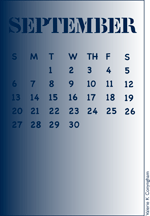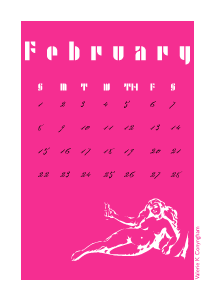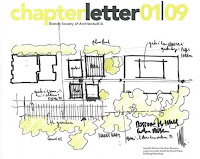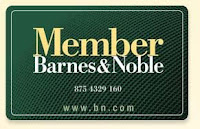Saturday, November 28, 2009
Marketing Engagement has moved
Wondering why I moved? You can find out here.
Wednesday, September 2, 2009
Keeping in touch - a reminder
 I’m a salon hopper. It’s not that I’m not happy with the umpteen places I’ve been too, but none of the salons I’ve visited have ever encouraged me to come back. So the next time I need my hair done I find another salon (I live in an area with hundreds of them) with a new customer discount, book an appointment, get my hair done and repeat the process in another 4-5 months.
I’m a salon hopper. It’s not that I’m not happy with the umpteen places I’ve been too, but none of the salons I’ve visited have ever encouraged me to come back. So the next time I need my hair done I find another salon (I live in an area with hundreds of them) with a new customer discount, book an appointment, get my hair done and repeat the process in another 4-5 months.What should these salons be doing? At the very least they should be encouraging me to book my next appointment on my way out. And if they haven’t done that, well then hopefully they’ve taken the time to collect some minimal contact information from me so that they can keep in touch while I’m between cuts.
It’s a story that’s all to common, and not just with salons. We’re often so busy trying to win new clients and servicing the ones that are in front of us that we loose sight of the previous clients whom we’ve finished servicing.
Keeping in-touch with past clients should be one of our biggest priorities. Everyone knows the saying it’s harder/more expensive to gain a client than it is to retain an existing one. Yet more often than not we’re so focused on winning the next job that we forget to reach out to established clients that may have another project waiting for us in the wings.
There are a number of simple things we can do – send them the firm’s newsletter, connect with clients on social networks you both participate in, add them to the holiday card list, send out a post-services survey. But more important than those tactics and more personal, keep a list of the important clients – the ones that you want repeat business from – and pick up the phone once a quarter. Give them a call to see how their new office building/home/whatever it is you did for them is working out. Share some news that might be applicable to them, ask to take them out to lunch, anything in order to have a quality conversation. With minimal effort your firm is back in the consideration set next time they’re looking for a designer. And all it cost you was a little bit of your time, and maybe lunch.
I realize I’m not conveying anything new here, but based on a few conversations of late I felt it was a good time for a reminder. So if you’re not already doing it, stop, make a list of past clients and pick up the phone. You’ll be amazed with the results.
Image credit: Flickr user stpiducko
Monday, August 31, 2009
What's your responsibility to your employer?
 I was reading an article on-line about Mayor Menino, Shirley Kressel and the Boston Redevelopment Agency. Shirley Kressel, a landscape architect, is a long time voice against the BRA and has been lobbying for its demise, as have the candidates running against Menino in Boston's mayoral race. I have many opinions about the race, the candidates and the issues surrounding them, but I will not share them here. Instead, what I'd like to explore are the individual responsibilities we have to our employers when it comes to political activism, particularly those whose work is primarily in the public sector.
I was reading an article on-line about Mayor Menino, Shirley Kressel and the Boston Redevelopment Agency. Shirley Kressel, a landscape architect, is a long time voice against the BRA and has been lobbying for its demise, as have the candidates running against Menino in Boston's mayoral race. I have many opinions about the race, the candidates and the issues surrounding them, but I will not share them here. Instead, what I'd like to explore are the individual responsibilities we have to our employers when it comes to political activism, particularly those whose work is primarily in the public sector.It's reasonable to say that if you owned a design firm that was working with or hoped to secure work with a particular public agency you would not hire a candidate with a history of opposing your client/prospect. It just doesn't make business sense. But what if you hired someone that had no obvious opinions about your clients/prospects, at least not initially, but then began publicly announcing, either through words or actions, that they held disdain for them? As an employer what are your options? Can you ask the employee to abstain from sharing their views on the client and/or prospect, even if it stifles their freedom of speech? Can you fire them if their activism becomes problematic in securing work from the client/prospect, without risking a wrongful termination lawsuit? And from the employee side, do you have an obligation to abstain from becoming involved in a political campaign/cause that has the potential to negatively affect your employer, even if it's something your believe strongly in?
I imagine these questions will become more prevalent with the increasing adoption of social media. Social media gives everybody a (louder) voice while giving more controls to employers wanting to keep tabs on what their employees are up to outside of the office (which in itself brings up another ethics question - should employers keep tabs on employees' personal lives just because the tools are available to do so?).
As information becomes easier to share and get it brings up new questions related to appropriate employer/employee relationships. If your firm starts thinking about them now so that there is a strategy (that's been run through legal) in place your job will be easier when (if) you run into the questions posed above. And if you've already been in any of the above situations and have feedback you'd like to share, I'd love to hear it.
Image credit: Sniderscion on Flickr
Sunday, August 30, 2009
Breaking the rules and transfering from Blogger to Wordpress
 Before I started my blog I began reading lots of other blogs to get the lay of the land. I started commenting and engaging with blog authors and I began looking for tips on beginning your own blog. One of those tips, which I am now breaking, is to pick a platform and stick with it - forever. I choose Blogger. It was free, I already had a google account, it had the functionality I was looking for and it had an easy interface that made posting to it a breeze.
Before I started my blog I began reading lots of other blogs to get the lay of the land. I started commenting and engaging with blog authors and I began looking for tips on beginning your own blog. One of those tips, which I am now breaking, is to pick a platform and stick with it - forever. I choose Blogger. It was free, I already had a google account, it had the functionality I was looking for and it had an easy interface that made posting to it a breeze. Two years later and I no longer think it's the best tool for me. Wordpress is easier to customize, stats are built right in and there's more flexibility to the design and different pieces of content you can add.
So here I am breaking one of the rules. I'm migrating to Wordpress. For the time being I'll keep both blogs going while I get a hang of Wordpress. And I'll think of what to do with the two years of content living at Blogger; let it live there or transfer it to Wordpress one post at a time.
For now you can find me at Blogger and Wordpress, both with the title Marketing Engagement by Valerie Conyngham. It's where I post about everyday marketing ideas that strike me, with a particular bent toward the design industry, as in architectural.
And if you're thinking about breaking any of the rules, I'd say go for it. Remember, technology changes often and our best offensive strike is to be flexible. Live by rules, but not rigidly.
Image credit: Flickr user givepeaceachance
Thursday, August 27, 2009
Free 2009 Calendar - Download September
 September's calendar design is inspired by back to school season. It is meant to evoke transition. I choose the color blue for September, not to comment on the blues of leaving summer behind, but rather to play upon the popular uniform color which many of Boston's children don.
September's calendar design is inspired by back to school season. It is meant to evoke transition. I choose the color blue for September, not to comment on the blues of leaving summer behind, but rather to play upon the popular uniform color which many of Boston's children don.Click here to download September from my website.
Print on 5x7 card stock. I use eco-white from Paper Source.
Friday, August 21, 2009
Building a Better Website
When looking for a service provider there are key things you look for - reputation, alignment of services offered with needs, trust and value.
Reputation can be earned through existing client relationships, which in turn create word of mouth referrals to your firm. Reputation can also be enhanced through media stories (assuming they're positive) and through the reputations of individuals that serve as the face of your organization. These types of things generate content for a firms' news section. Something most firms are already incorporating into their on-line presence.
For alignment of services with needs we're going to assume, for the sake of simplicity, that the visitors to your website need the services you provide. Your only responsibility is clearly communicating what services you provide. Remember - you don't have to be everything to everyone. Focus on what you do best and communicate that.
Now the meatier part - value. Let's think about how a design firm can provide value. Hint - it has nothing to do with fees. Instead it's giving clients value for their investment. A design firm can do this in many ways. As an example, perhaps you differentiate yourself through a unique public engagement process that's been shown to generate buy-in from stakeholders earlier in the design phase. That's valuable; buy-in is key in many projects and getting it earlier in the design process saves time and money. Tell your prospects about it through case studies that show solid metrics, post the case studies on your website and drive traffic to them through SEO optimization, e-newsletters, status updates in LinkedIn, etc. Or maybe your visualization services are superior to other firms, explain that to you prospects by telling them why it's important. Does it save them money, or make approval processes easier, or does it make the overall project less time consuming? Talk about your visualization services in the context of how they will solve your prospects' problems, not in the context of "look how pretty these are." Explain what you mean by visualization and give solid examples. Tie the examples back to metrics if you can.
Now on to trust. Trust is a lot harder to win on a website, particularly a static one. But by incorporating a blog into your website you have a vehicle to start a conversation with your prospects. A blog can be used to position members in your firm as thought leaders. It gives people a forum for expressing ideas and communicating thoughts and if comments are allowed (and they should be) it gives readers an opportunity to interact with the blog's writer(s) which will put you on the road to gaining trust. However, before incorporating a blog make sure you have buy-in and commitment from the would be authors. There's nothing worse than a blog that goes for weeks on end with no updates.
The above isn't an exhaustive list of things that would make AEC websites (or any websites) better, but it's a start and I hope it makes you think a little harder about the content you're incorporating. The point to leave with is showing a bunch a pretty pictures, while attractive, doesn't tell your prospects why you're better. You need to explain that through non-promotional, educational content.
While a picture is worth a 1000 words, your competitors "1000 words" are just as appealing.
Oh, and heavy flash sites are just annoying. They take up a lot of bandwidth, some companies restrict access to flash sites on their employees' computers and if the version of flash you've built your site with isn't compatible with the version a prospect has on his or her computer you can guarantee they're leaving your site before setting (the figurative) foot in it.
Sunday, August 9, 2009
Top 10 Twitter Tips for the Design Crowd
- Dive in personally, then transfer what you’ve learned to help your company succeed on Twitter.
- Concentrate on quality of followers, not quantity of followers
- Share valuable content, remember it’s not all about you
- The RT (that’s twitter speak for retweet) is the equivalent of telling someone “hey, I like what you’ve got to say.”
- Follow people. You don’t want to be that company that’s only interested in having people listen to them. Not sure who to follow? Find a few people you respect on Twitter and check out who they’re following.
- Expect organic growth, rarely are there overnight successes on Twitter or any platform for that matter.
- Participate. Twitter, like any social media platform, is only as good as the effort you’re willing to invest in it.
- Let people know you’ve joined twitter - add a link in your email signature, blog about it, talk it up in your newsletters.
- Follow people in your industry and learn from them.
- And because Twitter can turn into a huge time suck if you let it, get organized. Use an application like TweetDeck to categorize the people you follow by topic, get notice of your mentions and direct messages, shorten your URLs and handle multiple Twitter accounts, all within the same window.
Friday, August 7, 2009
Not Everybody has to Like You
 We all want to be liked; it’s human nature. And we often carry that need into our businesses. We’re not likely to turn down a paying opportunity, particularly in today’s economic environment. But there are many we shouldn’t be wasting our time on.
We all want to be liked; it’s human nature. And we often carry that need into our businesses. We’re not likely to turn down a paying opportunity, particularly in today’s economic environment. But there are many we shouldn’t be wasting our time on.In recessionary times our firms’ mantras tend to shift from niche, niche, niche to diversify, diversify, diversify. Diversification is important. The firms that focused all past efforts on developer projects are likely not doing that well today. Those that focused solely on municipal work are probably doing OK today, but what about tomorrow. The point is, diversification is an important strategy, provided the execution is smart. It’s when firms take the position of trying to be everything to everybody, just to get work in the door, where things start to fall apart.
I’m sure you’ve noticed your competition on any number of job opportunities has increased. But if you take a close look at the competition you can break it down into three categories:
- The usual suspects; all qualified to win the job.
- The bottom feeders, you know, the guys that are sort of qualified, but appear even more qualified when they start low-balling the bid.
- And then there are the firms that are diversifying.
Number three isn’t too much of a worry for you. Yes, you may be among 40 respondents instead of 10, but those that are qualified will rise to the top. Those diversifying for the sake of diversifying aren’t going to get much consideration (unless they hold brand creed and the prospect is swayed by that over credentials which is another post altogether).
The firms that are scared and turning that nervousness into a diversification strategy that’s more akin to ready, fire, aim are setting themselves up for failure. Instead they should reflect on their strengths, put thought into where true areas for growth are and pull together a strategy to enter those markets in addition to their existing ones. Better yet, develop and execute your diversification strategy before you need one. But when crafting it, remember, not everyone has to like you. It’s only important to be liked by the ones offering the projects that are a fit for your firms’ strengths.
Originally written for Help Everybody Everyday
Image Credit: wanderinghome on flickr
Friday, July 31, 2009
August Calendar - Free Download
 The next month in my 2009 Calendar series is right around the corner. August is now ready for download from my website. I call this month Ode to Catherine. Catherine is my husband's mother and I've always admired her handwriting. I find it so captivating that I had a custom font made from a sample of her writing. August features that font. Thanks to Font Shop for doing such a great job at recreating her artistic strokes.
The next month in my 2009 Calendar series is right around the corner. August is now ready for download from my website. I call this month Ode to Catherine. Catherine is my husband's mother and I've always admired her handwriting. I find it so captivating that I had a custom font made from a sample of her writing. August features that font. Thanks to Font Shop for doing such a great job at recreating her artistic strokes.
Wednesday, July 29, 2009
Finding Focus
 If you've been following this blog you've noticed my lack of attention to it in the past few months. I'm sure the reason is similar to those you've read on other blogs - lack of time, lack of energy, lack of, well, creativity. Marketing Engagement started out as a collection of marketing thoughts from my everyday life. And there are moments throughout everyday where something strikes me from a marketing perspective. But the reality is you can get those thoughts everywhere and I'm not adding much value in that space.
If you've been following this blog you've noticed my lack of attention to it in the past few months. I'm sure the reason is similar to those you've read on other blogs - lack of time, lack of energy, lack of, well, creativity. Marketing Engagement started out as a collection of marketing thoughts from my everyday life. And there are moments throughout everyday where something strikes me from a marketing perspective. But the reality is you can get those thoughts everywhere and I'm not adding much value in that space.In light of that, I've been struggling with where to take this blog. And while I've been taking a break from blogging I've become addicted to Twitter. I'm following a lot a great people and I feel the content I share there is valuable. And that leads me to where this blog should go next. The most valuable content I share on Twitter is for the A/E/C market. I've worked in various design firms over the past 12 years (minus a 2 year voyage to the dental insurance industry) and it's an industry I'm truly passionate about. Most design firms are small and there are minuscule resources dedicated to marketing. Often there's no marketer on staff, other times it's a junior person or the joint responsibility of the office manager. However, marketing is one of the most important things a firm can do for itself. I've been in the industry long enough to know where the pain points are and I'm confident I can dispel useful information to anyone involved in marketing their design firm. With that I'm realigning the focus of this blog to marketing within design firms. I'll still have the occasional non-related, thoughts from everyday posts, they'll just be interspersed with industry related posts. And I'll still be posting my 2009 calendar month by month. When I'm not here, I'll be contributing to Help Everybody Everyday, another blog, with lots of guest contributions on marketing in the A/E/C industry. If you find my content helpful, you'll find the content there just as good.
Thank you for reading and I hope you find the next iteration of this blog just as useful as the first.
image credit: Juan Eduardo Donoso on Flickr
Sunday, July 26, 2009
Great Interactive from Barnes & Noble
 I was reading my stream of Twitter updates and was excited about a tweet from @themarketingguy. He pointed his followers to the Barnes & Noble app on the iPhone. If you download it, it comes with a coupon for a free tall hot or iced coffee at a Barnes & Noble Starbucks stores. The tweet was simple "The Barnes & Noble iPhone app comes with a free cup of coffee." I immediatley downloaded the app to my iPhone and retweeted @themarketingguy's tweet. Barnes & Noble gets more face time with me, @themarketingguy gets validity to his tweet through an RT (that retweet speak in twitter) and I get a free cup of coffee and an app that I'm likely to use regardless. The lesson to be learned? Sometimes it's a tiny little thing (like a cup of coffee) that helps you to interact with your audience, gain word of mouth and make a great impression. Just think, already this went from app to twitter to blog. Where will it go next? Good press for a buck plus change.
I was reading my stream of Twitter updates and was excited about a tweet from @themarketingguy. He pointed his followers to the Barnes & Noble app on the iPhone. If you download it, it comes with a coupon for a free tall hot or iced coffee at a Barnes & Noble Starbucks stores. The tweet was simple "The Barnes & Noble iPhone app comes with a free cup of coffee." I immediatley downloaded the app to my iPhone and retweeted @themarketingguy's tweet. Barnes & Noble gets more face time with me, @themarketingguy gets validity to his tweet through an RT (that retweet speak in twitter) and I get a free cup of coffee and an app that I'm likely to use regardless. The lesson to be learned? Sometimes it's a tiny little thing (like a cup of coffee) that helps you to interact with your audience, gain word of mouth and make a great impression. Just think, already this went from app to twitter to blog. Where will it go next? Good press for a buck plus change.image credit: webgrl on Flickr
Thursday, July 23, 2009
Don't let industry jargon consume your firm's identity
It’s not that this description doesn’t sound great. The problem is it doesn’t mean anything. And if you argue that it does then I’ll counter with it doesn’t differentiate you from all the other firms that also think it means something.
Think back to when you took your first position in your first design firm (assuming you’re not a trained architect or other design professional that was already intimately familiar with the vernacular). Did you truly understand what your firm did and how it was different from all the other firms that surrounded it and claimed to be doing the same thing?
If you didn’t understand how your firm was different by reading the available materials (website, brochures, industry profiles, etc) than how are your prospective clients supposed to know what makes you different? An important reminder for us is that our prospective clients are not likely to be architects or know the language of architecture. They’re hiring us because they need our expertise.
Take a look at your marketing materials with fresh eyes and evaluate what the material is really trying to tell its audience. Do you use unique methods to provide innovative designs to your clients’ complex problems using a collaborative team approach or does your team of 3 designers spend a day on site with your clients before they begin designing a new space so that they can fully understand, and design a space that responds to, the clients’ challenges and goals? Which is clearer to you? Which do you think is clearest to your prospective clients?
There isn’t a secret formula for achieving clarity. All you need to do is write with your audience in mind and be transparent about your firm’s strengths. Don’t hide them in a sea of buzzword-laden text. Your prospective clients will thank you for your clarity by awarding you with their business. It sounds simple, but looking at the majority of design industry websites, instilling clarity through the written word remains a challenge.
Originally written for Help Everybody Everyday
Wednesday, July 1, 2009
July calendar ready for download
 We may be having cloudy skies in Boston this summer, but July's calendar is designed to evoke a zen like state of soaking up the sun (wearing sunscreen of course) on the beach. Download today and print out on 5x7 cardstock.
We may be having cloudy skies in Boston this summer, but July's calendar is designed to evoke a zen like state of soaking up the sun (wearing sunscreen of course) on the beach. Download today and print out on 5x7 cardstock.
Tuesday, June 2, 2009
June Calendar - Free download

The June installment of my 2009 Calendar series is now available for download. Prints out 5x7. Enjoy!
Saturday, May 2, 2009
May Calendar for Download

Another month means another edition in my 2009 calendar is ready. May is now ready to download. It's formatted to print out at 5x7 and looks great on white card stock. Visit my website to download May now.
Wednesday, April 22, 2009
Get Happy Fast
 Take a break out of your day and read The Toilet Paper Entrepreneur's list of 199 Ways to Get Happy Fast. My contribution is tip number 52 (though right now number 52 is listed twice, maybe once you click through that will be fixed and my tip will be number 54). Anyway, here's my tip to get happy fast:
Take a break out of your day and read The Toilet Paper Entrepreneur's list of 199 Ways to Get Happy Fast. My contribution is tip number 52 (though right now number 52 is listed twice, maybe once you click through that will be fixed and my tip will be number 54). Anyway, here's my tip to get happy fast:How To Get Happy Fast: Yoga – Have an instructor come to your office once a week. It gives you a scheduled break and permission to take your mind off of everything but yourself for an hour. During the ohm, visualize where you want your business to be then start planning to make it happen.
When you're done getting happy take a look through his other blog posts for tips on how to make the most out of your business.
Image by: Shunpikie
Monday, March 30, 2009
Corporate Blogs and Freedom of Expresion
Another company may take a different approach where there are parameters around what the content can be. That too is a viable strategy so long as there is no one in the background editing and putting the corporate spin on the posts. Blogs have different voices unique to their writer(s). It’s the personality that comes through in a blog which makes it more engaging for its readers.
The HOK blog is a testament to what a corporate blog should aim to be, an unfiltered collection of messages. It gives the reader a glimpse into the culture of HOK in a way that polished corporate messages cannot.
Sunday, March 29, 2009
April Calendar Ready for Download

Another month in my calendar series is ready to download. I call the design for April Cracked Eggs. As always it's sized to 5x7 and prints great on eco-white card stock from Papersource. Download now.
Friday, March 13, 2009
Creating new products that solve needs
 Some of the best (or at least most ingenious) product ideas are born to solve a need that many people don’t realize they have. It’s that ah-ha moment when you see something and ask, why didn’t I think of that? It’s that simple idea you think of that on the surface seems to be common sense. That was my feeling as I read the sponsored ad in yesterday’s morning edition of HARO (if you’re not a member of HARO you should join now – in short its PR leads delivered to your inbox three times a day).
Some of the best (or at least most ingenious) product ideas are born to solve a need that many people don’t realize they have. It’s that ah-ha moment when you see something and ask, why didn’t I think of that? It’s that simple idea you think of that on the surface seems to be common sense. That was my feeling as I read the sponsored ad in yesterday’s morning edition of HARO (if you’re not a member of HARO you should join now – in short its PR leads delivered to your inbox three times a day).Back to the ad – it was for SmartMom, makers of teethable bling. Essentially it’s jewelry for mom that looks like real stones, but that’s made out of safe materials for baby to chew. Wear it when you’re with your little one and you’ll always have that much needed thing to chew on, a way better solution than whipping out the car keys for baby.
Of course, the real test is does it really solve the need effectively – having something attractive to wear that is durable (no more broken dainty necklaces from chubby little hands grabbing at them) and doubles as a teething ring? Not having any babies in the house I won’t be testing it out myself. But I’ll keep my eyes open as I pass all the new moms strolling along Newbury Street this spring.
One thing that SmartMom can teach us is to pay attention to the people around us. There are new product opportunities all around us. As marketers, we need to tune in and listen. Find the need and create your product to solve it. Then make sure people realize the need exists and that yours is the right product to satisfy it.
Wednesday, March 11, 2009
Setting Goals
 Setting goals - the tangible, reachable kind – is one of the most important things you can do for your business. A goal gives you something to focus on and set in varying stages of complexity they allow you to map out a future for your company. Having a mix of long and short term goals helps a company and its employees to stay focused.
Setting goals - the tangible, reachable kind – is one of the most important things you can do for your business. A goal gives you something to focus on and set in varying stages of complexity they allow you to map out a future for your company. Having a mix of long and short term goals helps a company and its employees to stay focused.It’s easy for a firm to become so overwhelmed with the day to day that everyone becomes a master at production and so when a new project lands on the boards people start working immediately with no though to goals. No one asks – what’s the goal for this project? Is it to produce a 15 percent profit, to break even, but be well aligned for future projects or do you realize you’ll likely lose money on the project but you’re willing to take on the risk because it’s got the potential to be an award winner for your firm?
Starting with a goal in mind will help you to better align your marketing and business development efforts. A firm whose goal is to make a 15 percent profit on all projects will run differently and seek out different clients than a firm whose goal is to line its walls with award winning projects. Goals are individual and fluid; they can be changed or re-aligned over time. The key is in establishing your goals early. That’s what will position you for greater success down the road.
Image from flickr, by quasimondo
Thursday, March 5, 2009
Thursday, January 29, 2009
Download the calendar for February 2009
 Last month I started designing a calendar for 2009. I'm posting a new month every month and encourage you to download it, pass it along to your friends or post it somewhere else. February is done and ready for you to enjoy. You can download it here. It's 5x7 and looks great printed on white card stock. Enjoy!
Last month I started designing a calendar for 2009. I'm posting a new month every month and encourage you to download it, pass it along to your friends or post it somewhere else. February is done and ready for you to enjoy. You can download it here. It's 5x7 and looks great printed on white card stock. Enjoy!
Sunday, January 18, 2009
Developing Staff in a Downturn
 Following is the text from an article I wrote for the Boston Society of Architects ChapterLetter. The article is geared toward the design community and how important it is to maintain a firm's most important asset - its people, but the basis of the advice applies to any company.
Following is the text from an article I wrote for the Boston Society of Architects ChapterLetter. The article is geared toward the design community and how important it is to maintain a firm's most important asset - its people, but the basis of the advice applies to any company.An economic downturn can present a number of opportunities for the forward thinking firm, including developing your staff with free money from the state. The hurdle is the reduction in billable hours and what that means to a firm’s bottom line. Maintaining the right size staff is a challenge for any company in any industry. A balance needs to be achieved in billable hours and overhead and in slowdowns overhead is often first on the chopping block. Instead of reducing staff to the lowest level needed to complete the work in hand, it’s wiser to continue operating with the best staff to help a firm grow. That means keeping those employees with great promise, but minable projects in hand happily employed.
With more overhead hours available there’s more time for professional development, an often-overlooked benefit during times with heavier workloads and more demanding schedules. One way to use a downtime productively is to invest in new technology, such as Building Information Modeling (BIM) and the training it demands. And the silver lining is that many Massachusetts employers are eligible for training grants that can pay from 50 to 100 percent of an employee’s training costs.
Massachusetts has three types of grants available through its Workforce Development Fund. Grants include Express Grants, General Grants and Hiring Incentive Training Grants (HITG). Express Grants are limited to employers with 50 or fewer employees and pay 50 percent of an employee’s training costs within a year, up to $15,000 per applicant. Training courses must be chosen from a pre-approved list of courses registered with the state. Current pre-approved courses include classes on Solidworks and AutoCad; ArchiCAD BIM courses are pending approval and should be included among the pre-approved course list within the month. The grant application is simple and the turn-around time is quick.
General Grants are available to any size company and can be used toward courses of the applicant’s choice. Grant matches can be in-kind or cash and higher levels of grant money are available to companies creating significant job growth or higher levels of job retention. While General Grants can be generous and courses aren’t limited to a pre-approved list, the application process is arduous, requires a significant amount of preparation and can have a three to four month timeframe for approvals.
HITG Grants are available to companies hiring a person who has been unemployed for one year or permanently separated from his/her previous employer. These are the richest grants available from the perspective that there is no monetary employer contribution required toward the training, with the exception of paying the attendee’s wages during the training time. Applications must be filed within 30 days of a new hire’s start date and the application has a quick three day turnaround.
To learn more about Workforce Training Funds or to apply for a grant visit http://tinyurl.com/6lynna.
Friday, January 16, 2009
Tylenol warms Boston
 Tylenol's newest outdoor advertising campaign is amazingly cool, or warm as it may be. The company is running a series of advertisements on outdoor bus shelters promoting their warming liquids line. What makes the campaign unique is in addition to the traditional printed billboard, Tylenol has installed heat lamps on the inside of the shelters the company is advertising on. The ads play on the theme of warm up with Tylenol warming liquids and standing in the bus shelter, looking at the ad you can literally warm up. What resonates most about this campaign is the product solves a need (providing a quick warm to your otherwise feverish, cold, sick body) but so too does the advertising. And on a cold Boston day there is nothing better than catching a spot under the heat lamps when you're standing and waiting for the bus. Thank you Tylenol!
Tylenol's newest outdoor advertising campaign is amazingly cool, or warm as it may be. The company is running a series of advertisements on outdoor bus shelters promoting their warming liquids line. What makes the campaign unique is in addition to the traditional printed billboard, Tylenol has installed heat lamps on the inside of the shelters the company is advertising on. The ads play on the theme of warm up with Tylenol warming liquids and standing in the bus shelter, looking at the ad you can literally warm up. What resonates most about this campaign is the product solves a need (providing a quick warm to your otherwise feverish, cold, sick body) but so too does the advertising. And on a cold Boston day there is nothing better than catching a spot under the heat lamps when you're standing and waiting for the bus. Thank you Tylenol!
Wednesday, January 14, 2009
Free font helps save ink
 Is one of your New Year's resolutions to be more earth friendly? Here's a creative way from SPRANQ to help you achieve your goal. They've developed a font, available as a free download, which uses up to 20 percent less ink than traditional fonts. There has been a lot of emphasis the past few years to reduce paper, but ink usage also contributes to waste. Ecofont, based on the font Verdano, is versitle enough to be used for the majority of your business printing needs such as letters, contracts, faxes and more, which means you could significantly reduce this year's printing budget. It's another opportunity for your business to prove its committement to going green. Download ecofont today and start saving money while doing your part to conserve more resources. Hat tip to Springwise for bringing ecofont to my attention.
Is one of your New Year's resolutions to be more earth friendly? Here's a creative way from SPRANQ to help you achieve your goal. They've developed a font, available as a free download, which uses up to 20 percent less ink than traditional fonts. There has been a lot of emphasis the past few years to reduce paper, but ink usage also contributes to waste. Ecofont, based on the font Verdano, is versitle enough to be used for the majority of your business printing needs such as letters, contracts, faxes and more, which means you could significantly reduce this year's printing budget. It's another opportunity for your business to prove its committement to going green. Download ecofont today and start saving money while doing your part to conserve more resources. Hat tip to Springwise for bringing ecofont to my attention.
Thursday, January 8, 2009
It's about real connections, not numbers
 Dear All, I’d like to expand my network…It’s a statement that’s all too popular on LinkedIn Groups. It’s a bad side effect of the counters used on the various social networking sites – how many friends, how many connections, how many followers and the egos they create as the numbers climb. It’s time to return to the old adage, quality over quantity. Social networking, like traditional networking should be about making real connections, not to serve as a collection spot for the contact information of hundreds of people you don’t know and will probably never know.
Dear All, I’d like to expand my network…It’s a statement that’s all too popular on LinkedIn Groups. It’s a bad side effect of the counters used on the various social networking sites – how many friends, how many connections, how many followers and the egos they create as the numbers climb. It’s time to return to the old adage, quality over quantity. Social networking, like traditional networking should be about making real connections, not to serve as a collection spot for the contact information of hundreds of people you don’t know and will probably never know.I'm not saying don't connect with people you know, even people you know loosely . But I am asking why would you want to connect with a complete stranger whose main goal is to increase the number of his or her connections? If there's no relationship, there's no need to pretend one exists.
Here's some advice for everyone who want to add more connections - get out and meet people. Go to conferences, networking events, seminars, volunteer for an organization that resonates with you, join a neighborhood group, etc. Meet people, have a conversation, think about what value you can offer them, then ask to connect.
Image by Wen Z.
Friday, January 2, 2009
The value of paid membership programs
 For the past two years I've purchased the Barnes and Noble Membership Card, but this year when my membership came up for renewal I faltered. My membership served me well. I first purchased it during a period in my life when I was going to graduate school and the discounts on textbooks paid for the membership. The value was there and I was happy to pay the $25 yearly membership fee. There's also the psychological aspect of saving ten percent on all your purchases just feels good, even if it's only on a cup of coffee. And the reality is, after the first outlay of $25 you begin to forget you had to pay for the privilege of saving.
For the past two years I've purchased the Barnes and Noble Membership Card, but this year when my membership came up for renewal I faltered. My membership served me well. I first purchased it during a period in my life when I was going to graduate school and the discounts on textbooks paid for the membership. The value was there and I was happy to pay the $25 yearly membership fee. There's also the psychological aspect of saving ten percent on all your purchases just feels good, even if it's only on a cup of coffee. And the reality is, after the first outlay of $25 you begin to forget you had to pay for the privilege of saving.But then life changed, I graduated with my Masters and no longer needed to buy textbooks and Borders set up shop in my neighborhood. Borders has a free membership program, one of the benefits being a weekly coupon, usually for 20 to 30 percent off the list price of one item. I tend to only buy one item at a time so the free membership outweighs the paid membership for me.
The sad thing (for Barnes and Noble) is I still spend an equal amount of time at Barnes and Noble. I prefer Barnes and Noble to Borders. But now I'm just browsing at Barnes and Noble. When I'm ready to make a purchase I wait for my weekly coupon to show up in my email (it was even better when it showed up as a text message to my phone) and I stop in at Borders on my way home from work to pick up the book I eyed at Barnes and Noble.
If you're offering a paid membership program, no matter how insignificant the price - it's best to keep track of your competitors free programs and make sure you outshine the free program in a multitude of ways. The answer need not lay in matching discounts, but could instead focus on service extras. Ideas include priority lines, VIP reading sections in the store, call ahead shopping services, table reservations at the in-store Starbucks, etc. A paid membership program should be more than a blanket discount on goods, it needs to be special and hold true value for the people willing to pay for it, not just a simple calculation of if I spend $250 per year at Barnes and Noble I should purchase the membership card.



